You need to hire people, lease, or buy property, get all the necessary licenses from your city council--the list goes on and on.
If you are interested in setting up a warehouse and distribution facility, you need to know just how much money to invest first. Starting with a blank slate is one of the best ways to begin. You have just signed the lease to a new warehouse and are now looking to set up a distribution facility within.
It’s the dream step for many growing businesses. However, it also requires a considerable amount of thought. There are a lot of factors to consider when setting up a new warehousing facility, from the equipment to the layout to the processes.
The equipment, for instance, makes for an extensive list, but you can largely divide the machinery and equipment into certain categories: order picking equipment, storage equipment, material handling machinery, and operational equipment. The buck doesn’t just stop with buying the necessary equipment; you also need to create an efficient layout.
Ideally, you would want to:
- Establish a management system
- Maximise operating area
- Improve efficiency
- Keep a tight hand on inventory
- Ensure worker safety
Before you start buying machinery and equipment, you need to have a clear idea about the kind of items that will be stored within. Does your business primarily sell identical items or lots of unique products with different sizes? If items need to be picked individually, you must deploy a comprehensive inventory control system in your warehouse.
In the following paragraphs, we shall talk about some of the most common items that you will need to manage your warehouse effectively.
Order Picking Equipment
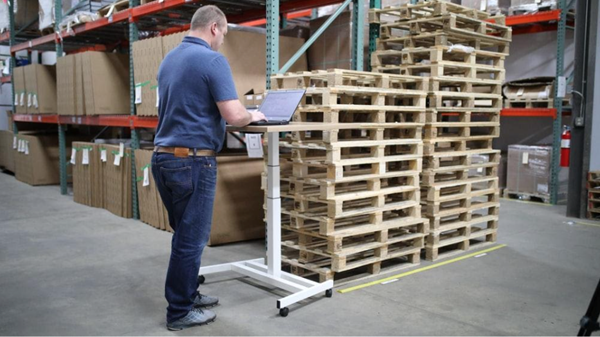
Palletising and packing operations can be handled in several ways. Packing and picking equipment is needed to individually pick items from the warehousing facility, pack them, and then fulfill customer orders. This is one of the key functions in a warehouse, and generally the most expensive.
Order picking is critical for the success of any distribution facility. You need to firstly decide about the best order picking system to deploy in your distribution facility. Here are some popular orders picking methods:
- Single order picking: employees generally pick SKUs on an individual basis based on order details. This is ideal for smaller warehouses.
- Batch picking: this method improves speed and efficiency by retrieving SKUs in bulk. It’s ideal for warehouses that receive several orders for similar SKUs.
- Zone picking: for this method to work, the layout of the warehouse must be divided into zones. Each zone has its own team. Employees pick SKUs from specific zones and then pass off the carton to a different zone. Once all the SKUs are retrieved, the carton is packed and shipped through a central location.
To increase order picking efficiency, you will require the following equipment:
- Electric Order picker forklifts: these forklifts are designed to elevate employees to a higher level to retrieve SKUs.
- Pallet jacks: pallet jacks can either be hand pallet jacks or electric pallet trucks. They can be used to move items from one place to another.
- RFID readers or barcode scanners: modern warehouses generally add RFID or barcodes to each SKU. This makes it easy to locate and retrieve SKUs from different shelves. Employees scan each item as it’s picked. This reduces errors in order picking.
Apart from that, you will also require:
- Dock boards and container ramps
- Wheel chocks
- Dock seals
- Truck restraints
- Levelling jacks
- Restraint systems
- Gantry cranes and hoists
This equipment will make it easy for your warehouse staff to pick orders and then load them onto the trucks.
Storage Equipment
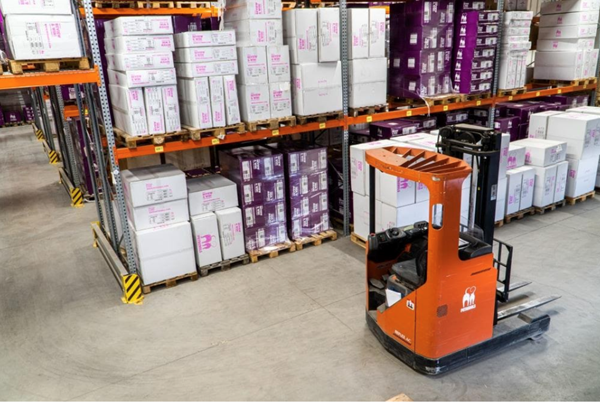
Items in a warehouse can usually be stored in one of two ways: either on dedicated shelving or racks or in bulk pallets on the floor. Storage pallets are generally stacked one on top of another, in order to fully utilise the greater space upwards. Warehouses typically have taller ceilings, so vertical storage allows for more efficient use of space.
Ideally, when setting up a warehouse, you will want to pay close attention to the storage equipment. You will require several types of storage equipment.
Pallet Racking
Pallet racking is perhaps the most commonly used type of storage equipment in a warehouse. The racks are stacked either horizontally or vertically, with pallets. This allows order pickers to easily SKUs individually or in batches. Two commonly used types of warehouse pallet racking systems include push-back pallet racks and selective pallet racking.
Selective pallet racking is quite popular and usually features a modular, bolt-on configuration. The pallets are placed on load beams that are connected to mounting clips. This allows operators to quickly adjust the racking for variable loads.
On the other hand, push-back pallet racking is designed to maximize storage area while cutting down on aisle space. Wheeled carts are used for storage, connected to rails. Forklifts can be used to place the pallets onto the carts, allowing one to bump into another, thus rolling several pallets forwards or backwards.
Of course, apart from that, you will also require:
Material Handling Machinery
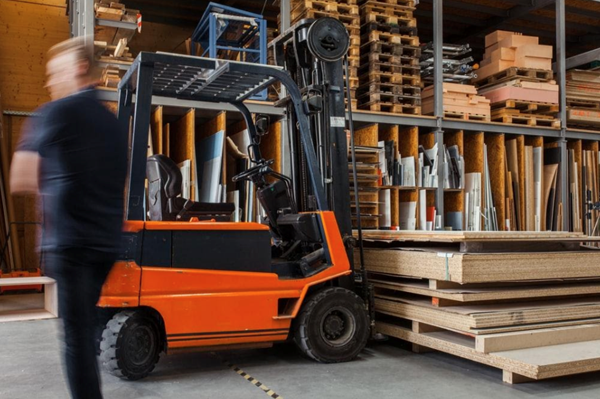
Material handling machinery is incredibly important in a warehouse or distribution facility. This refers to equipment and machinery that is required in order to lift and move SKUs from the shelves to the packing area. Material handling equipment is generally designed to improve efficiency and to reduce operator fatigue.
Material handling simply refers to the loading and unloading of inventory in a warehouse setting. It requires employees to use electrical and mechanical devices to move things around easily and efficiently. This equipment is critical to maintaining efficient warehouse function.
More importantly, material handling machinery can be broadly divided into three categories: dedicated engineering systems, bulk handling equipment, and industrial trucks.
Dedicated Engineering Systems
Dedicated engineering systems are generally employed in warehouses with a higher degree of automation. For instance, automated guided vehicles (AGVs) are now used in many high-tech warehouses. These are load carriers that move around the warehouse, moving inventory without requiring a driver.
AGS usually feature standard navigation sensors onboard to allow them to move through a densely packed environment. They usually rely on laser navigation, LiDAR, or even geoguidance, requiring little to no modification to the internal infrastructure of the warehouse.
Another popular example of dedicated engineering systems is the Automated Storage and Retrieval System. This system usually relies on conveyor belts to allow for efficient inventory movement.
Bulk Handling Equipment
If you have items in loose bulk stored in the warehouse, you need bulk handling machinery. Essentially, this machinery will allow you to move large quantities of material throughout the warehouse. Here’s what you will need:
Hoppers: these are designed for storing material in loose bulk, such as grain. It has a release door at the bottom that can be used to dispense specific quantities.
Bucket elevators: these are designed to store items in large buckets and transport them.
Conveyor belts: These are used to quickly retrieve material from different parts of the warehouse.
Industrial Trucks
Smaller vehicles are generally used in warehouses for moving materials in an efficient manner. Instead of workers doing everything by hand, industrial trucks and warehouse vehicles allow them to cut down on physical exertion and use machinery to do the heavy lifting.
Pallet trucks: both manually operated and electrical-powered options are available. They can be used to move pallets.
Side-loaders: in narrow or very narrow aisle spaces where a conventional forklift or truck cannot be used, side-loaders are needed for loading or unloading materials.
Dollies: dollies are standard platforms with four wheels, usually pushed by hand. They are used for moving inventory throughout the warehouse. They are available in different sizes. Popular variants include pry dolly, the furniture dolly, and the drum dolly.
Hand trucks: these are different from dollies. Hand trucks generally feature two larger wheels and have an L-shaped design. Once loaded, they are designed to stand upright and can be moved by tilting them slightly backwards.
Platform trolleys: these are very similar to conventional dollies, though the platform is generally wider, allowing operators to move greater amounts of inventory in one go.
Operational Equipment
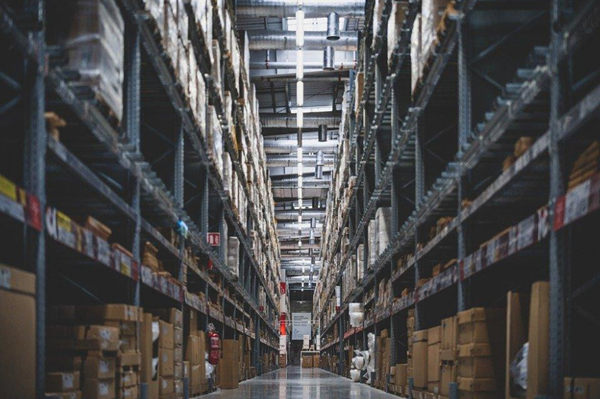
Operational equipment is critical in a warehouse for efficient management. On a typical day, thousands of SKUs are brought in or moved out of the warehouse. Operational equipment is necessary for tracking all of the items coming in and going out.
The use of operational equipment is essential for warehouse employees. It allows them to quickly sift through pick lifts and retrieve SKUs. Perhaps the greatest example of operational equipment in a warehouse includes warehouse RFID gates or barcode scanners.
RFID allows for rapid tag detection as goods are brought in or taken out of the warehouse. They use passive antennae and UHF RFID for reliable detection and reduced error. Management software is used throughout the warehouse to track the inflow and outflow of goods.
Usually, warehouses rely on the FIFO (first in, first out) accounting method for managing inventory. Most warehouse inventory control software already features pre-set controls for maximizing efficiency. For instance, in most warehouses, items that are moved frequently are stored closer to the picking point. This helps increase picking efficiency.
Other examples of operational equipment in a warehouse include:
Workbenches: these are used for storing tools or other equipment.
Packing tables: packing tables can be used by employees to pack SKUs in cartons and prep them for shipping.
Pallet wrapping machines: used for stretch wrapping goods.
Industrial scales: larger industrial scales are used for weighing materials. This includes checkweigher bench scales, floor scales, and pallet scales.
Barrier rails: used to increase worker safety and protect expensive equipment.
Bollards: bollards serve as a barrier in certain spaces, preventing forklifts from entering spaces where valuable equipment is stored.
Handrails: designed to enhance worker safety in walkways and mezzanine spaces.
Floor safety signs, bins, chairs, and tables: all of these are needed for the smooth functioning of the warehouse.
Banding equipment: this is necessary for banding products together and prepare them for shipping.
First aid kits: both Class A and Class B safety kits should be available in the warehouse. Both should contain alcohol, treatments for burns, antiseptic, and other aids. Class B kits also have specialised equipment in case of a serious accident.
CCTV surveillance Cameras: used for surveillance
Fans, heaters, air conditioners: used for maintaining airflow in the office.
High-visibility clothing and hard hats: high-vis vests and hard hats must be worn by workers for their own safety.
Harnesses: to mitigate the risk of injury in case of a fall, order pickers might also need to wear harnesses.
Labelling machines: these are used for labelling items.
Tips for Setting Up the Warehouse
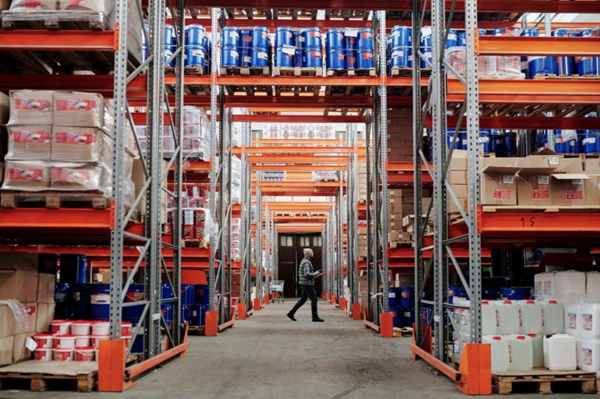
If your warehouse is not set up correctly, even the most expensive equipment will not increase efficiency. Ideally, when setting up the warehouse, you need to define a few primary objectives.
Focus on Efficiency
Efficiency in the warehouse will reduce order picking times and increase inventory flow, both in and out. You need to focus on reducing the distance between items that need to be moved in or out. Moreover, the frequency with which they must be handled should also be reduced.
Inventory Management
An efficient warehouse must have a system in place for managing and tracking inventory. Identifying where specific items are kept is necessary for smooth operations.
Space Management
You need to maximize the space available in the warehouse. This doesn’t just mean cramping all of the items together; workers must have adequate room to move about and retrieve items. Items shouldn’t be spaced too far apart, but they shouldn’t be all that close either.
Safety
Employees must be well-trained, and adequate safety equipment should be always available in the warehouse. Once you have identified the main objectives, it’s time to focus on best practices.
Establishing the Workflow
When planning the layout and design of your warehouse, you need to visualize the workflow. From the moment inventory is brought in, you need to have a clear picture in mind about where it’s going to go. Items need to be tagged and stowed. Items moved frequently must be stored closer to the docking bay to reduce handling and picking times.
You can create a map of workstations and identify key areas. One-way workflows are quite popular in warehouses and distribution facilities and reduce traffic.
Use a Warehouse Management System
A dedicated warehouse management system can automatically generate pick slips, provide information about empty shelves, stocking locations, and track inventory movements. This is essential for getting a better understanding of how inventory and items are moved throughout the warehouse.
Optimize the Packing Area
When planning your workflow, you need to focus on both picking and packing. Once orders are picked, the pickers should have a clear idea of where they must be dropped. The packing area should be optimized to receive goods from the pickers, and adequate machinery must be available for wrapping and packing items for distribution.
The Bottom Line
The best way to set up a warehouse and distribution facility is to start by keeping your needs front and centre. What are the most common tasks that will be performed in the warehouse? What kind of inventory will you be dealing with? Then, visualize and chart your workflow, and eventually plan the layout.
You can then purchase relevant equipment, thus saving you time, money, and energy for many years to come.


















